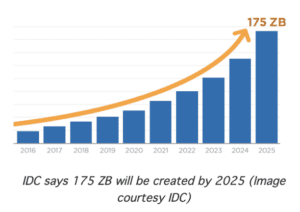Intelligent Data Management Supports Sustainability
The rapid advancement of technology has led to a staggering increase in digital content. Managing data and cloud services is key to reducing the carbon impact.
NOTE: The views expressed here are solely those of the author and/or interview subject and do not represent positions of IEEE.
In the digital age, the rapid advancement of technology has led to a staggering increase in digital content. Every text message, email, photo, video, document, presentation, or spreadsheet contributes to a massive scale of digital content, some of which is archived for future use, while others are less important and don’t get deleted.
Data is generated by nearly every business and human on the planet. Even with proper management, the growth in digital content is likely to continue. With the recent COVID-19 pandemic, as people relied more heavily on working, learning, and being entertained from home, digital content grew by more than 56% from 2019 to 2020, more than twice the growth seen from 2018 to 2019. Data creation is projected to grow at a compound annual growth rate of approximately 19% to more than 180 zettabytes (ZB) by 2025.

Sidebar: What is a ZB exactly? A zettabyte is a digital unit of measurement. One zettabyte is equal to one sextillion bytes or a trillion gigabytes.
 According to IDC, the Global Data Sphere quantifies and analyzes the amount of data created, captured, and replicated in any given year across the world. This figure includes data created by corporate enterprises, governments, academic institutions, and the global network of consumers.
According to IDC, the Global Data Sphere quantifies and analyzes the amount of data created, captured, and replicated in any given year across the world. This figure includes data created by corporate enterprises, governments, academic institutions, and the global network of consumers.
Much of this data is stored in digital warehouses called data centers. Very large data centers are referred to as hyperscalers.
As reliance on digital storage grows, so does the environmental impact of the storage industry and the importance of managing digital waste. The term “digital waste” refers to the environmental burden caused by the production, use, and disposal of digital devices and data storage systems. It encompasses the device’s life cycle assessment (LCA) including the energy consumption and carbon emissions associated with data storage and processing as well as the electronic waste (e-waste) from the discarded hardware such as computers, smartphones, and storage devices. The disposal of electronic devices, often containing toxic substances, poses an environmental threat if not managed properly.
When it comes to sustainability in the digital content context, there are several areas of focus. Energy efficiency is key in storage systems, particularly within data centers and hyperscalers. In addition, the move toward renewable energy, natural air circulation, and efficient use of water at these data centers makes a significant impact. Data center optimization and virtualization also supports sustainability. By consolidating data storage and processing in centralized data centers, the storage industry can optimize resource utilization, reduce energy consumption, and minimize the need for individual physical storage devices.
2023 IEEE President-Elect Tom Coughlin knows about digital storage and its management. He has spent his career in the digital storage space as an engineer, author, and consultant. In his various IEEE publications, Coughlin speaks to the various aspects of the digital content space, including the sustainability impacts of this explosion of data.
An area of interest to Coughlin is the domain of data sanitization. Storage devices have a lifecycle that requires upgrades during certain period intervals. These devices don’t last forever, so before they fail, which can be catastrophic, the data center will routinely upgrade storage devices for reliability purposes. Today, many of these devices are incinerated or melted, making it difficult to reclaim their parts and materials to manufacture new devices. To help data centers be more comfortable releasing intact storage devices for recycling, the data stored on that device needs to be scrubbed, or sanitized, prior to the device’s retirement.
IEEE publishes a collection of standards on environmental assessments of electronic products. Coughlin specifically mentions the IEEE Standard 2883™-2022, or the IEEE Standard for Sanitizing Storage1, which specifies methods of sanitizing logical storage and physical storage, as well as providing technology-specific requirements and guidance for the elimination of recorded data.
Coughlin goes on to describe the value of such a standard: “There are parts in the devices, such as the rare earth metals in a hard disk drive (HDD), that have a good economic value, but those rare earth metals can be difficult to remove from a HDD that has been melted or incinerated. The idea of the standard was to prevent somebody from getting access to the data off a recycled storage device. The standard around media sanitization methods eliminates the data on the storage device itself and makes that data uneconomical to recover. By encouraging people to use the standard, especially those who have a lot of hard disk drives and other storage devices, the sanitized drives can now be part of an aftermarket for used storage devices, thereby creating a circular process.”
According to Coughlin, moving data within a data center is a large component of a data center’s carbon emissions. He says, “Data centers are interesting. Their footprint, in terms of percentage of total global power consumption, has stayed about the same for the last ten years. That’s because they’ve made advances in technology that reduce power consumption and also new approaches to using renewable energy sources such as solar and wind power. An interesting point is that the biggest use of power in data centers is often managing data. So, there is a big focus on reducing data movement to decrease energy consumption, such as moving domain-specific processing in or close to digital storage and memory devices.”
Much research is being done to arrive at solutions that manage data while reducing energy needs. A recent article in IEEE Transactions on Sustainable Computing, Energy and Network Aware Workload Management for Geographically Distributed Data Centers2 presents a novel game-theory-based workload management framework that takes a holistic approach to the cloud operating cost-minimization problem by making intelligent scheduling decisions aware of data transfer costs and the data center queueing delay.
As incoming President of IEEE, Tom Coughlin is clear that this organization can help in solving future climate change–related problems. “A lot of the problems the world faces are multidisciplinary issues, and IEEE has experts in almost every aspect to help solve those problems,” he says. “Technology is the best way we have of dealing with a lot of these things. IEEE is a real resource to the community in general. Technology creates potential, and it’s a general engineering principle to try to be as efficient as you can and not waste resources.”
[1] IEEE Standard for Sanitizing Storage. (2022).IEEE Std 2883-2022, [online] pp.1–67. doi: https://doi.org/10.1109/IEEESTD.2022.9856626
[2] Hogade, N., Pasricha, S. and Siegel, H.J. (2022). Energy and Network Aware Workload Management for Geographically Distributed Data Centers. IEEE Transactions on Sustainable Computing, 7(2), pp.400–413. doi: https://doi.org/10.1109/tsusc.2021.3086087


